The Evolution of Sacred Art: Understanding the Modernist Crucifix
A modernist crucifix is a contemporary reinterpretation of the traditional Christian symbol that emerged in the mid-20th century, characterized by abstract forms, minimalist design, and innovative materials like brass, teak, and mixed metals.
For those seeking quick information about modernist crucifixes:
| Characteristic | Description |
|---|---|
| Time Period | Primarily 1950s-1970s |
| Materials | Brass, teak, mixed metals (10k-18k gold) |
| Price Range | $400-$1,500 depending on materials and provenance |
| Key Features | Abstract corpus, geometric forms, negative space |
| Notable Examples | Meštrović's 1916 Geneva crucifix, Swiss mid-century brass/teak designs |
Unlike traditional crucifixes that emphasize realistic suffering, modernist crucifixes often present Christ's figure through abstraction, focusing on the symbolic rather than the literal representation of the crucifixion. This artistic approach aligns with broader 20th-century movements that sought to strip religious imagery to its essential meaning.
The popularity of modernist crucifixes peaked during the mid-century modern period (1950s-1970s), with many notable examples combining brass structures with hand-carved teak figures. These pieces often display a "floating" Christ figure that emphasizes dignity and transcendence rather than physical suffering.
For funeral homes and memorial spaces, modernist crucifixes offer a contemporary alternative that can complement modern architecture while maintaining the essential symbolism important to Christian traditions. Their clean lines and minimalist aesthetics make them particularly suitable for chapels seeking to create a serene, contemplative atmosphere.
I'm Mortuary Cooler, a national-level mortuary equipment supplier with expertise in helping funeral directors integrate meaningful religious symbols like the modernist crucifix into contemporary memorial spaces. My experience with modernist crucifix selection has shown they can significantly improve the aesthetic and spiritual quality of viewing rooms.
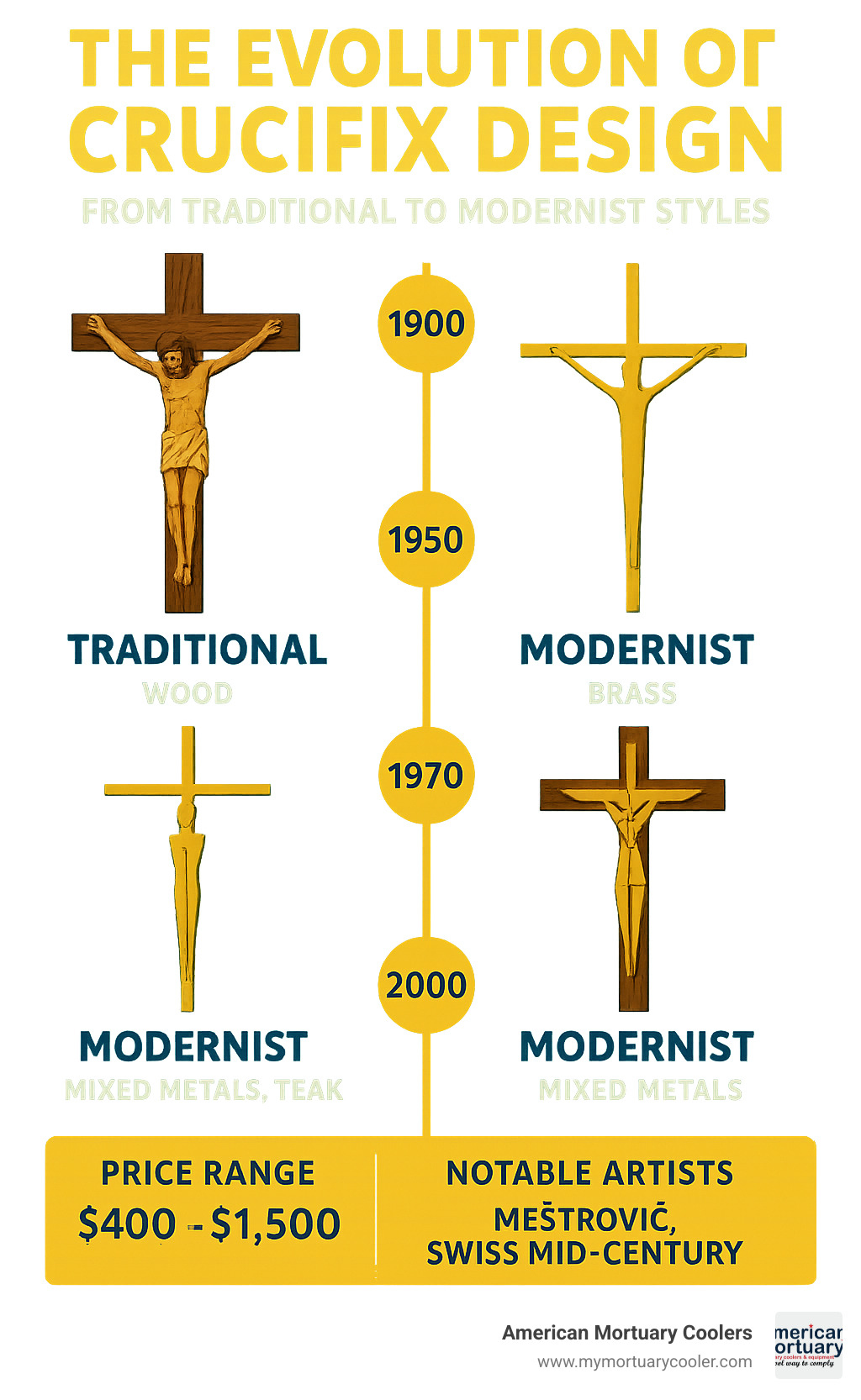
Basic modernist crucifix terms:
Modernist Crucifix: Definition & Distinction
When you first encounter a modernist crucifix, you'll immediately notice how it breaks from centuries of traditional religious art. Born in the aftermath of World War II, these striking pieces speak the visual language of their time—embracing clean lines, bold materials, and a fresh spiritual perspective.
What makes a modernist crucifix truly distinctive? At heart, these pieces reimagine Christianity's central symbol through modern eyes. They strip away elaborate detail in favor of essential meaning. The corpus (Christ's body) might appear as a series of neat geometric forms. The cross itself often celebrates the natural beauty of materials like brass or teak rather than hiding them under ornamentation.
"The modernist crucifix doesn't attempt to recreate the physical suffering of Christ in realistic detail," explains Henrik von Achen, art historian and deacon. "Instead, it invites the viewer to contemplate the theological meaning through abstraction and symbolic representation."
You can see the Bauhaus influence in many of these pieces—that design movement that valued honesty in materials and clarity of purpose. This approach represented a significant shift in religious art, especially following the Second Vatican Council (1962-1965), which encouraged greater artistic freedom while maintaining essential symbolic meaning.
| Traditional Crucifix | Modernist Crucifix |
|---|---|
| Realistic human anatomy | Abstract or geometric corpus |
| Emphasis on physical suffering | Emphasis on dignity and transcendence |
| Detailed facial expression | Minimalist or absent facial features |
| Naturalistic coloration | Monochromatic or material-focused |
| Ornate decorative elements | Clean lines and essential forms |
| Traditional materials (wood, ivory) | Innovative materials (brass, steel, mixed media) |
| Static, symmetrical composition | Dynamic, asymmetrical composition |
| Narrative focus | Symbolic focus |
Style, Materials & Iconography of a Modernist Crucifix
The beauty of a modernist crucifix often lies in its thoughtful simplicity. These pieces speak through form, space, and material in ways that feel both fresh and timeless.
The geometric corpus is perhaps the most striking feature. Rather than anatomical precision, you'll find Christ's form suggested through basic shapes—perhaps an elongated rectangle for the body with minimal indication of limbs. This abstraction invites a more contemplative relationship with the piece.
Negative space plays a powerful role too. Many brass crucifixes from the 1960s use empty space as intentionally as solid elements. These voids aren't empty at all—they're breathing room for spiritual reflection, creating visual tension that draws you in.
The materials themselves tell part of the story. Two-tone metals create meaningful contrast, like those stunning pendant crucifixes from the 1960s featuring "10k blackened white gold with an organic wood-grain texture" for the cross, while "the body of Christ is abstractly rendered in 10k yellow gold wire." This material distinction subtly separates the divine from the earthly.
Teak wood grain brings warmth and natural beauty to many modernist crucifixes, especially in Scandinavian designs. The honey-colored tones and distinctive grain patterns aren't hidden but celebrated—a testament to modernism's appreciation for authentic material expression.
Traditional Christian symbols get thoughtful reinterpretation too. A crown of thorns might appear as a simple circle. Christ's wounds might be suggested through texture changes rather than graphic detail. The INRI inscription might be reduced to abstract markings or omitted entirely. These choices maintain symbolic meaning while speaking in a contemporary visual language.
Modernist Crucifix vs. Historical Forms
To truly appreciate the modernist crucifix, it helps to understand what came before. Each historical period approached this sacred symbol with its own spiritual and artistic sensibilities.
The Romanesque Christus Triumphans (10th-12th centuries) portrayed Christ alive on the cross—eyes open, often crowned and robed as a king. These pieces emphasized triumph over death rather than suffering. Interestingly, many modernist crucifixes circle back to this triumphant theme, though through abstract means. The Romanesque crucifix at The Met demonstrates how "This large Crucifix represents Jesus hanging on the Cross, but nonetheless triumphant over death"—a concept of dignity that resonates with many modernist interpretations.
Gothic Realism (13th-15th centuries) introduced greater anatomical detail and emotional intensity. These crucifixes depicted Christ's suffering in increasingly graphic detail—the body contorted, the face anguished, with meticulous attention to wounds.
Baroque Drama (17th-18th centuries) took this emotional quality even further. These crucifixes used dynamic poses, strong contrast, and theatrical effects to evoke powerful responses from viewers.
The modernist crucifix makes a deliberate departure from these approaches. While Gothic and Baroque styles sought to move viewers through realism and drama, modernist designs engage the intellect through abstraction and symbolism. They invite you to complete the image mentally rather than presenting every detail.
As Henrik von Achen observes about the modern crucifix at St. Paul's Church in Bergen: "The figure appears to float rather than hang in suffering. The crucifix embodies simplicity and dignity over harsh realism."
In memorial spaces, this quality of dignified simplicity makes the modernist crucifix particularly appropriate. At American Mortuary Coolers, we've seen how these thoughtful pieces can transform a contemporary chapel space, creating an atmosphere of serene contemplation during life's most difficult moments.
Modernist Crucifix Materials & Techniques
The beauty of a modernist crucifix lies not just in its design, but in the thoughtful selection of materials that bring these sacred objects to life. These crucifixes blend traditional elements with fresh materials, creating pieces that speak to both faith and artistic innovation.
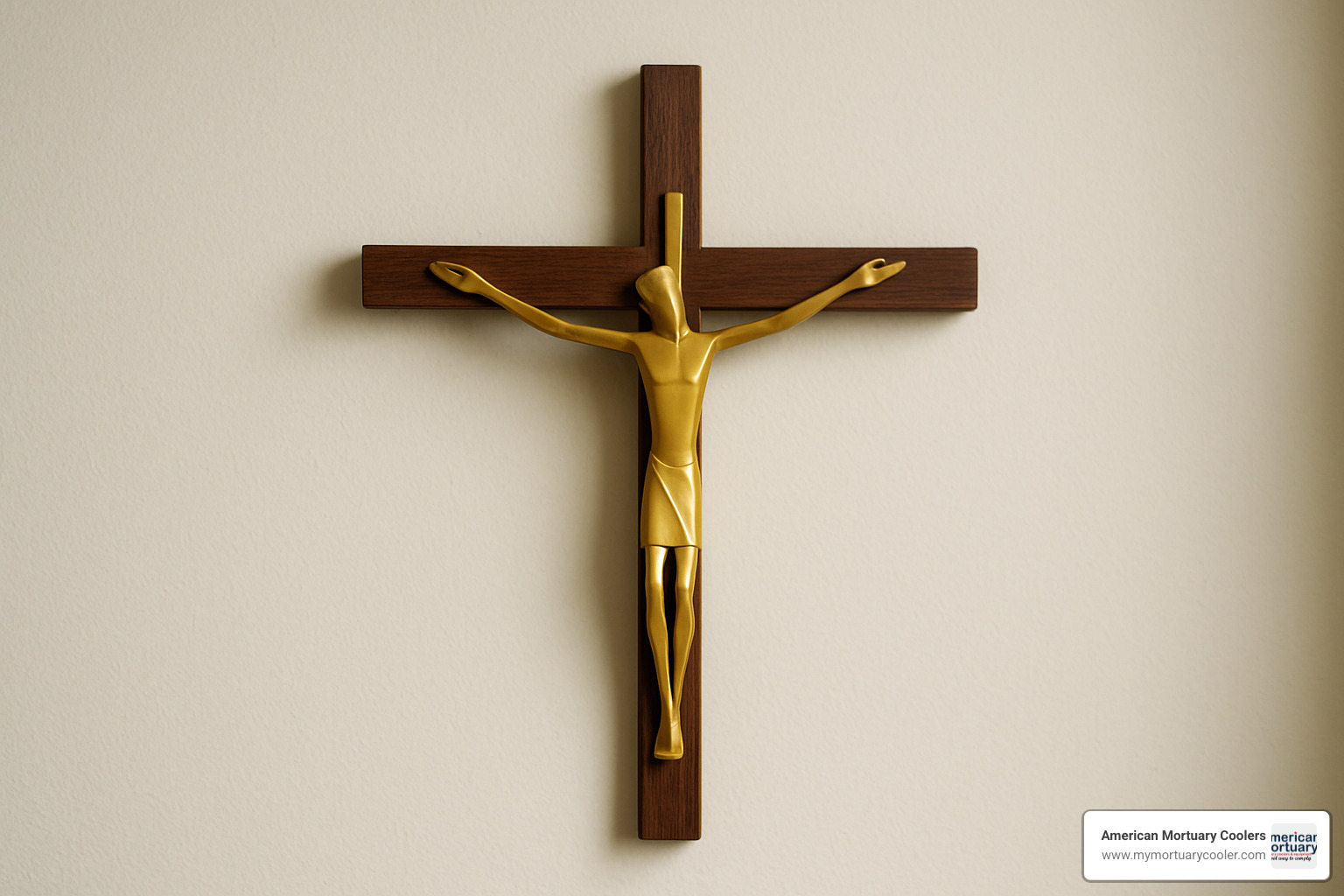
Brass became the darling of mid-century modernist crucifixes, and it's easy to see why. With its warm golden glow and ability to develop character as it ages, brass offered both beauty and durability. Many Swiss designs from the 1950s paired brass structures with other materials for striking visual contrast. One particularly noteworthy piece described as a "super neat, very puristic and imposing 1950s Swiss mid-century modern brass crucifix with hand-carved teak Jesus" showcases this perfect pairing.
The rich warmth of teak made it the wood of choice for Scandinavian designers creating modernist crucifixes. Its distinctive grain and natural beauty aligned perfectly with modernism's "truth to materials" philosophy. Rather than hiding the wood under paint or stain, modernist artists celebrated teak's natural character, letting the grain become part of the visual story.
For personal devotion, precious metals found new expression in pendant crucifixes. Moving away from ornate Victorian styles, gold (ranging from 10k to 18k) was reimagined in clean, minimalist forms. Some pieces, like the "Vintage Modernist 18 kt Yellow Gold 50×32 mm Crucifix Pendant," showcase this neat simplicity. Others played with contrast, combining "10k blackened white gold with an organic wood-grain texture" for the cross and "10k yellow gold wire" for an abstract corpus.
Welded steel brought industrial strength and contemporary relevance to larger crucifixes. Artists like Ivan Meštrović acceptd steel's expressive possibilities, creating works that felt both modern and timeless. These pieces often carry a visual weight that speaks to the gravity of their spiritual significance.
Ancient techniques found new life in modernist hands. Enamel work, particularly champlevé enamel, was reimagined with bold color fields rather than detailed scenes. Lost-wax bronze casting allowed for expressive, complex forms while maintaining structural integrity for church installations.
As environmental awareness grew in the 1970s, sustainable hardwoods beyond teak—including walnut, oak, and maple—became increasingly popular choices for conscientious artisans creating liturgical art.
What makes these modernist crucifixes so visually striking is often the thoughtful combination of materials. A brass cross supporting a teak corpus creates a dialogue between materials that mirrors the theological conversation between divinity and humanity.
Innovative Craft Methods Behind a Modernist Crucifix
Creating a modernist crucifix demands both traditional craftsmanship and innovative techniques—a perfect blend of old and new.
The art of hand carving remained essential, though modernist carvers focused on capturing essence rather than detail. Look at the abstracted teak Jesus figures from Swiss mid-century pieces, and you'll notice flowing, simplified forms with minimal tool marks. These pieces achieve spiritual resonance through suggestion rather than explicit detail.
Mixed-media lamination techniques allowed artisans to combine materials in structurally sound ways. Some pieces feature metal elements embedded within wood, while others create layered compositions that reveal different materials depending on your viewing angle. This technical innovation solved practical problems while creating visual interest.
The rich, varied surfaces of many brass and bronze crucifixes come from patinated finishes. These chemical treatments—creating blues, greens, or browns on metal surfaces—add depth and character while controlling how the piece will age over time. Some artists used patination to suggest age and continuity with tradition, while others sought more contemporary colorations.
Reflecting broader trends in industrial design, some modernist crucifixes employed modular assembly methods. These clever designs featured interlocking or replaceable components, making shipping and installation easier. Some even allowed for reconfiguration during different liturgical seasons—practical innovation serving spiritual needs.
At American Mortuary Coolers, we appreciate the craftsmanship behind these sacred objects. Just as modernist artisans blended tradition with innovation, we combine time-tested quality with forward-thinking design in our mortuary equipment. When displaying religious items in memorial spaces, these thoughtful material choices can create environments of both comfort and contemplation.
Landmark Modernist Crucifix Creations & Their Creators
The story of the modernist crucifix unfolds through several groundbreaking works that forever changed religious art in the 20th century. These pioneering creations didn't just challenge artistic conventions—they reimagined how faith could be expressed in the modern world.
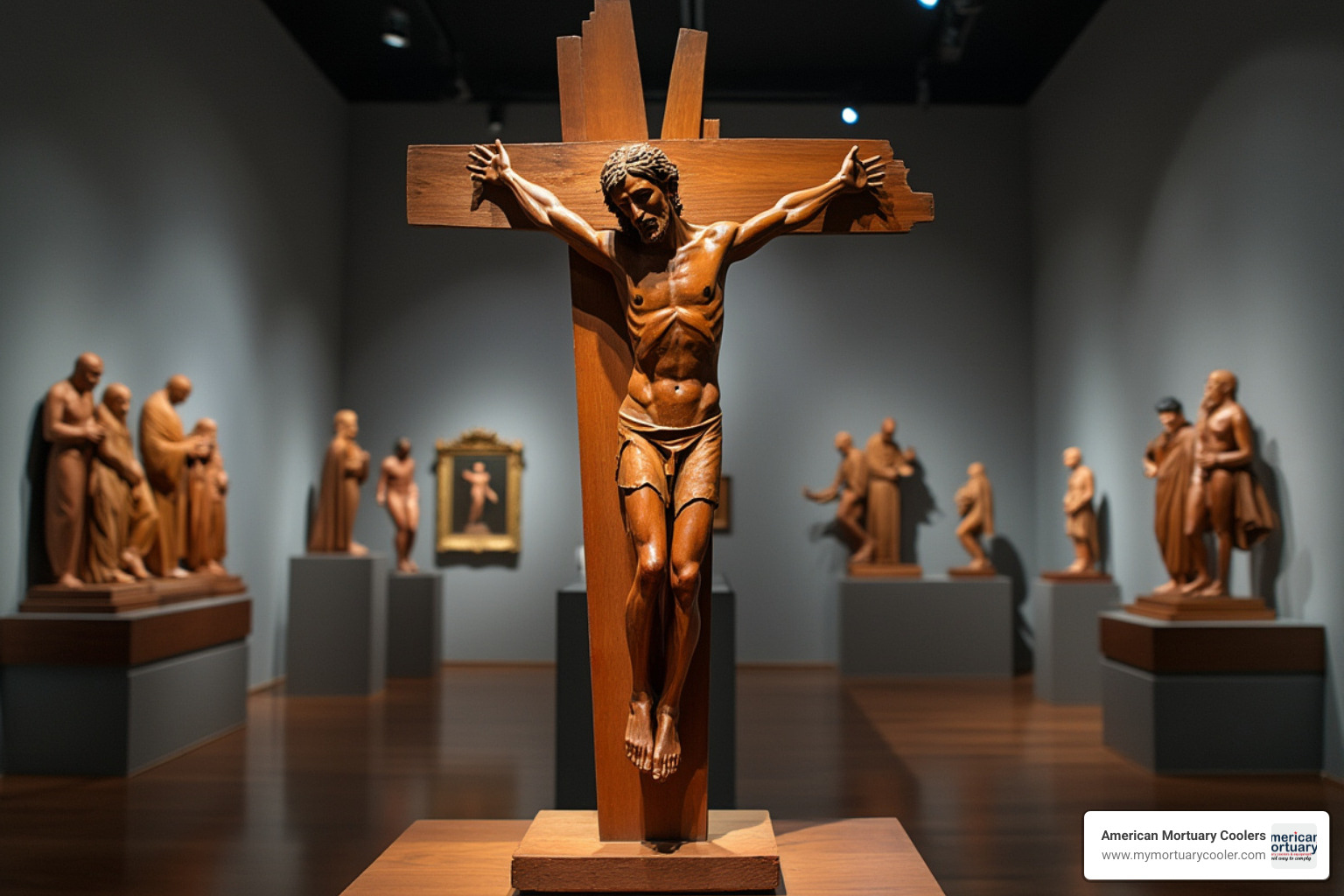
When Ivan Meštrović unveiled his 1916 Geneva Crucifix, it sent ripples through the art world. This wooden expressionist sculpture broke dramatically from tradition with its angular, abstracted Christ figure. Rather than depicting physical suffering through realistic detail, Meštrović conveyed spiritual anguish through distortion. The poet Ezra Pound famously criticized it as "paroxysmal" in The New Age (1917)—inadvertently highlighting exactly what made it revolutionary.
Meštrović wasn't finished with reinterpreting this sacred symbol. His later work "The Eternally Crucified" (1930), installed above the main altar of a family mausoleum church, showed how modernist approaches could retain profound spiritual power while completely reimagining traditional forms.
The clean lines of Swiss Mid-Century Crucifixes from the 1950s-1960s represent perhaps the purest expression of modernist principles in religious art. I've always been drawn to these pieces during my visits to European churches and private collections. They often feature brass structures supporting hand-carved teak figures, embodying the material honesty and functional beauty championed by the Bauhaus movement. One particularly striking example I've encountered was described as a "super neat, very puristic and imposing—1950s Swiss mid-century modern brass crucifix with hand-carved teak Jesus."
Traveling north, the Scandinavian Teak Pieces developed their own distinctive approach to the modernist crucifix. These works celebrate the warm, rich character of wood while maintaining clean, minimalist forms. Finnish and Danish designers in particular created pieces with flowing lines that seem to capture movement in static form—the wood grain itself becoming part of the artistic expression.
A more recent but significant contribution comes from Solrunn Nes's Bergen Cross created in 1991 for St. Paul's Catholic Church. Drawing inspiration from 13th-century Italian-Byzantine styles but viewing them through a contemporary lens, Nes created a crucifix that art historian Henrik von Achen describes beautifully: "The figure appears to float rather than hang in suffering," emphasizing Christ's transcendence rather than his physical torment.
The modernist vision wasn't limited to church walls. Jewelry-Scale Pendants brought these designs to personal devotional objects. These intimate pieces, often crafted in precious metals, allowed individuals to carry these contemporary expressions of faith close to their hearts. Notable examples include an neat "Vintage Modernist 18 kt Yellow Gold 50×32 mm Crucifix Pendant" and an innovative design combining "10k blackened white gold with an organic wood-grain texture" for the cross with "10k yellow gold wire" forming an abstractly rendered corpus.
What connects these diverse creations—from Meštrović's expressionist anguish to Scandinavian serenity, from church installations to pocket-sized pendants—is their shared commitment to speaking the language of modern art while honoring ancient Christian symbolism.
Case Study: Mid-Century Modernist Crucifix Pendants
The story of modernist crucifix design takes a fascinating turn when we examine how these bold artistic ideas were translated into personal devotional jewelry. These pieces show how modernism could be both intimate and portable.
A particularly striking example from my research is an 18 kt yellow gold pendant measuring 50 × 32 mm created in the 1960s. Unlike traditional crucifix pendants with their intricate details and ornate flourishes, this piece strips away everything but the essential forms. The cross and figure are reduced to their fundamental elements, embodying the modernist belief that "less is more." The warm radiance of the gold itself becomes the primary means of expression.
Even more innovative is a pendant described as a "Modernist interpretation of a crucifix necklace" from around 1960. This piece brilliantly combines "10k blackened white gold with an organic wood-grain texture" for the cross, while "the body of Christ is abstractly rendered in 10k yellow gold wire." The contrast isn't just visually striking—it's symbolically rich, distinguishing between the earthly (the cross) and the divine (the figure).
Today, these wearable modernist crucifixes command respectable prices, typically between $425 and $895 depending on materials, craftsmanship, and provenance. This relatively high valuation reflects both their artistic significance and their relative scarcity compared to traditional styles.
What makes these pendant crucifixes so special is their dual purpose. They served as both personal expressions of faith and as fashion statements aligned with mid-century modern aesthetics. They allowed wearers—particularly younger, design-conscious Christians in the 1950s-1970s—to carry a religious symbol that reflected contemporary sensibilities rather than merely repeating historical traditions.
In funeral settings, these smaller modernist crucifixes can serve as powerful memorial objects. At American Mortuary Coolers, we've seen how these pieces can be thoughtfully displayed near urns or incorporated into remembrance displays. Their intimate scale makes them ideal personal keepsakes for family members, creating a meaningful bridge between religious tradition and contemporary design that honors both the past and the present.
For those interested in historical religious art, the French medieval crucifix at The Met offers a fascinating contrast to these modernist interpretations, showing just how dramatically religious art has evolved over the centuries.
Theology, Culture & Regional Variations
The modernist crucifix isn't just a design statement—it reflects deeper shifts in how we understand faith in the modern world. These contemporary crosses tell a spiritual story that speaks to changing theological perspectives across different cultures.
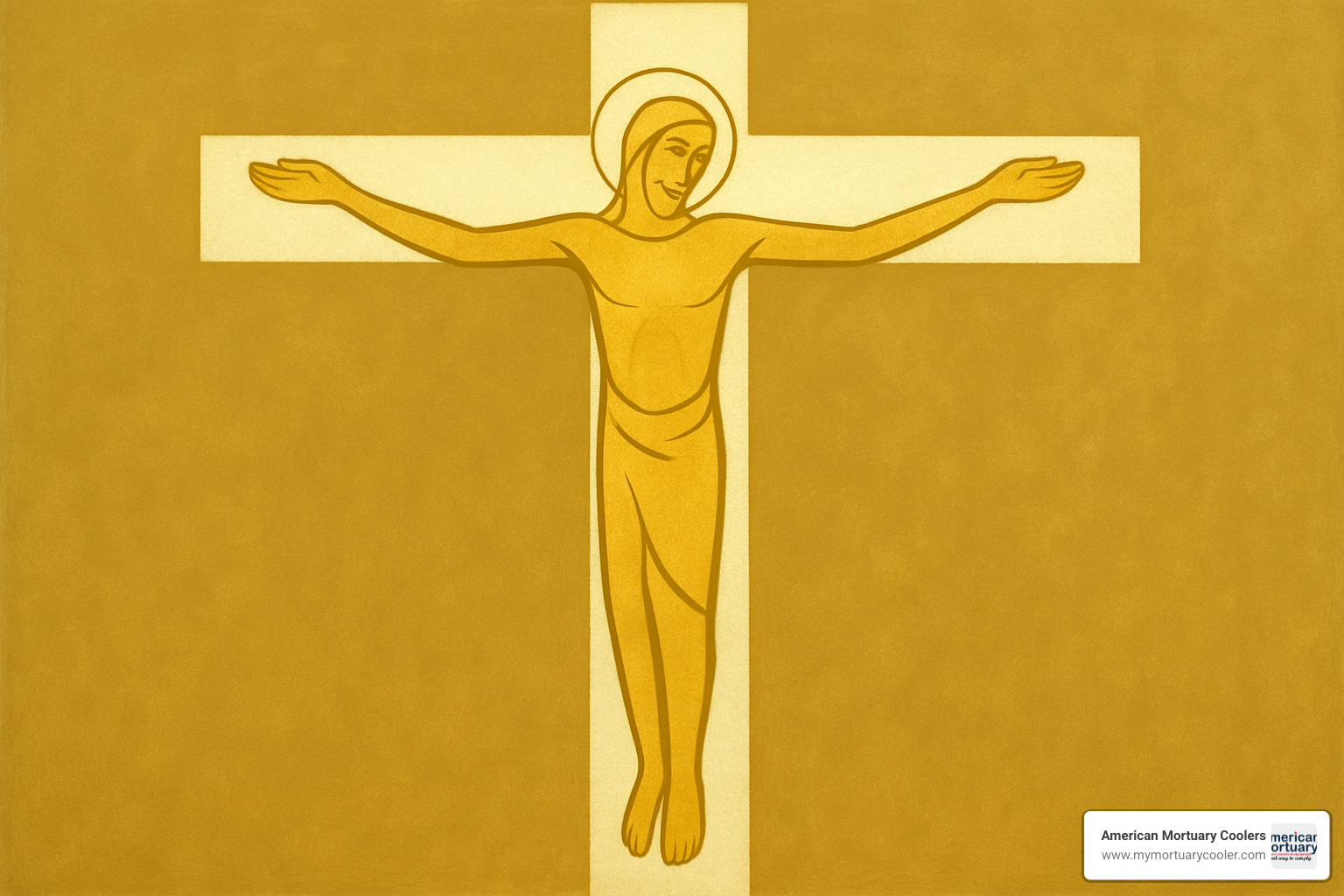
Many modern designs revive the Christus Triumphans concept, showing Christ as victorious even in death. Henrik von Achen beautifully explains this when describing the crucifix at St. Paul's Church in Bergen: "The crucifix visualizes the Eucharistic anamnesis, showing the risen Lord descending to communicate through bread and wine." This isn't just about remembering history—it's about experiencing Christ's continued presence in our lives.
On the other hand, the expressionist suffering approach, seen in Ivan Meštrović's powerful works, speaks to a different spiritual need. Using bold abstraction, these crucifixes express a spiritual anguish that goes beyond physical pain. After two world wars, these designs resonated deeply with Europeans who had witnessed suffering on an unprecedented scale.
What I find fascinating is how different regions have made the modernist crucifix their own:
In Scandinavia, Lutheran traditions naturally acceptd liturgical minimalism with clean lines and warm woods creating a sense of peaceful dignity. These crucifixes speak through their simplicity and quality materials rather than elaborate details.
If you've ever visited Latin America's concrete churches from the mid-20th century, you've probably been struck by their massive, simplified modernist crucifixes. Architects like Oscar Niemeyer created dramatic spiritual statements by placing these bold crosses against austere concrete backgrounds—the contrast is absolutely breathtaking.
Eastern European designers often kept traditional proportions while simplifying details, honoring their Orthodox heritage while embracing modern aesthetics. Meanwhile, American interpretations frequently celebrated industrial materials like welded steel, reflecting our nation's manufacturing identity with forward-looking optimism.
These regional differences show that while the modernist crucifix movement spread globally, it wasn't one-size-fits-all. Communities adapted these crosses to their unique cultural contexts while maintaining the core principles of abstraction, material honesty, and simplified forms.
How a Modernist Crucifix Engages Contemporary Audiences
Today's churchgoers and spiritual seekers connect with modernist crucifixes in ways that traditional crosses sometimes miss. Their ability to bridge ancient symbolism with contemporary sensibilities makes them especially valuable in our diverse world.
Many communities have finded social justice readings in these abstract designs. The simplified suffering figure can represent not just Christ but all who face oppression and injustice. This broader interpretation has made these crucifixes particularly meaningful in communities engaged with liberation theology and social activism.
The ecumenical appeal of modernist designs is another strength worth noting. By focusing on universal themes of sacrifice and transcendence rather than denomination-specific details, these crucifixes work beautifully in interfaith settings or spaces used by multiple Christian traditions. They speak a visual language that crosses theological boundaries.
When it comes to placement in modern chapels, these crucifixes need thoughtful consideration. Unlike ornate traditional crosses, modernist designs shine against clean, neutral backgrounds that let their distinctive forms stand out. In a funeral home chapel, a well-placed modernist crucifix creates a focal point that offers both spiritual meaning and visual harmony with contemporary architecture.
As one liturgical designer told me, "The best way to appreciate a modernist crucifix is to spend some time looking upon it and allowing it to speak to you through its form. These aren't symbols that reveal everything at first glance—they invite contemplation and personal interpretation."
Many communities now commission their own modernist crucifixes, working with contemporary artists to create pieces that honor both modernist principles and local traditions. These collaborative projects often result in meaningful crosses that connect artistic innovation with community identity.
For those of us at American Mortuary Coolers working with funeral homes, the modernist crucifix offers a perfect balance—creating environments that feel both timeless and contemporary, honoring traditional faith while acknowledging modern sensibilities. This balance helps funeral directors serve families with diverse generational perspectives on religious symbolism, creating spaces where everyone can find meaning and comfort.
Market Value, Collectibility & Care
The world of modernist crucifixes has become increasingly attractive to collectors and religious institutions alike, with mid-century pieces (1950s–1970s) now fetching between $400 and $1,500 on the market, depending on their pedigree and condition.
What makes these spiritual art pieces so valuable? It comes down to several key factors that collectors and chapel directors should understand.
The materials used play a huge role in determining price points. Precious metal examples naturally command premium prices in today's market. Just look at the difference between an 18kt yellow gold modernist pendant crucifix currently listed at $895, while a similar 10k gold piece from the same era asks $425. The material quality speaks directly to both durability and visual impact.
Provenance creates another layer of value, especially when a piece can be traced to a recognized artist or prestigious church installation. A modernist crucifix with documented connection to a master like Ivan Meštrović might sell for several times more than a similar anonymous piece. This history matters deeply to serious collectors.
Museum scarcity has also driven up values in recent years. Our research reveals that "on major art marketplaces, modernist examples make up less than 10% of all crucifix listings," while "Museum collections, such as The Met, feature only a handful of modernist crucifixes compared to hundreds of medieval and baroque examples." This relative rarity continues to push prices upward.
When displaying these special pieces, thoughtful presentation makes all the difference. Directional lighting that creates gentle shadows can highlight the three-dimensional qualities and textural contrasts that make each modernist crucifix unique. Many were originally designed to appear as if floating on the wall, so heavy frames or elaborate mounting systems can actually diminish their impact.
Context matters tremendously too. These pieces shine against neutral backgrounds that don't compete with their clean lines and honest materials. In funeral homes with contemporary chapel designs, we've noticed these crucifixes create a perfect spiritual focal point without overwhelming the space – making them suitable for services across different denominations.
As appreciation for mid-century design continues expanding beyond furniture into religious objects, the collectibility of these pieces grows steadily. For those building a collection, focusing on specific materials, regions, or time periods helps create a cohesive and historically meaningful grouping.
Caring for Your Modernist Crucifix in Home or Chapel
Taking proper care of a modernist crucifix ensures it maintains both its beauty and value for generations. The mixed-material nature of many pieces presents unique challenges that require thoughtful approaches.
Humidity control should be your first priority, especially for pieces combining wood and metal elements. Wood expands and contracts with humidity changes, potentially stressing joints or causing finishes to crack over time. In chapel settings, we recommend maintaining relative humidity between 40-60% to protect these treasured symbols.
UV-safe lighting protects wooden components from the silent damage of discoloration. While teak (a common wood in these pieces) naturally resists many forms of damage, it can still fade when exposed to strong ultraviolet light. LED lighting with minimal UV emission works beautifully for illuminating these pieces in both homes and chapels.
When it comes to cleaning, gentleness is key. For brass elements, usually a soft, dry cloth does the job for regular dusting. If tarnish appears, apply a mild brass cleaner sparingly with a soft cloth. The wooden components need only occasional dusting with a soft brush or microfiber cloth – avoid commercial furniture polishes that build up over time and hide the natural beauty of the wood grain. For precious metal elements, a jewelry cloth designed specifically for gold or silver maintains luster without scratching delicate surfaces.
Don't overlook insurance for valuable pieces, particularly those crafted from precious metals or created by recognized artists. A professional appraisal not only establishes value for insurance purposes but provides documentation that proves crucial if damage or loss occurs.
For funeral directors, we recommend creating a simple maintenance schedule for all religious artifacts in your space, including your modernist crucifixes. Regular inspection helps identify potential issues before they become serious problems, ensuring these meaningful symbols remain in perfect condition for the families you serve.
At American Mortuary Coolers, we understand that while our primary expertise is in cooling systems and related equipment, the proper care of all elements in a memorial space contributes to creating truly dignified, comforting environments. The right crucifix, properly maintained, becomes an essential part of creating meaningful funeral experiences that comfort families during difficult times.
More info about funeral home furnishings
Frequently Asked Questions about Modernist Crucifix Design
Why do modernist crucifixes favor abstraction over realism?
When you first encounter a modernist crucifix, you might wonder why artists chose to move away from the detailed realism of traditional designs. This shift toward abstraction wasn't simply an artistic whim—it reflected a profound rethinking of how religious symbols communicate.
Abstraction allows these crucifixes to speak directly to the spiritual essence rather than getting caught up in historical details. It's like the difference between reading a detailed news account versus a poem—both tell a story, but in very different ways. The abstract approach invites you to contemplate the deeper meaning of Christ's sacrifice rather than focusing on physical suffering.
"The crucifix embodies simplicity and dignity over harsh realism," explains Henrik von Achen about the St. Paul's Church crucifix in Bergen. This thoughtful approach creates a quiet, contemplative space where you can engage with the symbol on multiple levels—intellectually, emotionally, and spiritually.
There's also a beautiful honesty in how modernist crucifixes let their materials speak. The natural grain patterns in teak wood, the warm glow of polished brass, or the subtle luster of gold all become part of the expression. This celebration of material qualities aligns perfectly with broader modernist principles that valued authenticity across all art forms.
Are modernist crucifixes accepted in traditional liturgy today?
The story of how modernist crucifixes found their place in traditional worship spaces is one of gradual acceptance rather than overnight revolution. Following the Second Vatican Council (1962-1965), the Catholic Church opened its doors wider to contemporary artistic expressions, provided they still conveyed essential theological truths.
Today, you'll find many traditional parishes incorporating modernist elements, especially in newly built or renovated spaces. The key question isn't whether a crucifix follows historical conventions, but whether it successfully leads people toward contemplation of Christ's sacrifice and resurrection.
As one liturgical consultant beautifully put it: "What matters is not whether the crucifix follows historical stylistic conventions, but whether it leads the faithful toward contemplation of Christ's passion and resurrection."
In funeral home chapels, which often serve families from various faith backgrounds, a modernist crucifix can provide a meaningful symbol that resonates across different traditions while complementing contemporary architectural settings. Its simplified form often speaks to people regardless of their specific denominational background, creating a space that feels both sacred and welcoming.
How can I verify the authenticity and value of a vintage modernist crucifix?
If you've finded a modernist crucifix at an estate sale or inherited one from a family member, determining its authenticity and value involves a bit of detective work—but it's a fascinating journey.
Start by examining the materials closely. Precious metals should bear appropriate hallmarks indicating purity (10k, 18k, etc.). For brass pieces, look for a patina that develops naturally over decades—something that's difficult to fake. Construction methods can also reveal much about when a piece was made, as techniques evolved over time.
Next, consider the design elements. Authentic mid-century pieces display characteristic clean lines, minimal ornamentation, and material honesty that defined the era. Reproductions often miss subtle period details or mix elements from different time periods in ways that don't quite ring true.
Documentation makes a world of difference. Original purchase receipts, exhibition catalogs, or church records can transform a beautiful object into a piece with verified history. For significant works, you might even find mentions in design archives or period publications.
For valuable pieces, connecting with specialists who understand mid-century religious art can provide clarity. Auction house experts who focus on 20th-century decorative arts often have the specialized knowledge needed to evaluate these unique objects.
Finally, researching recent sales of similar pieces gives you the most accurate sense of current market value. Platforms like 1stDibs and specialized auction results provide helpful comparison points.
For funeral homes maintaining collections of liturgical objects, we at American Mortuary Coolers recommend periodic professional appraisals. This ensures your insurance coverage accurately reflects current values and that significant pieces receive the care and security they deserve as they continue to provide comfort to the families you serve.
Conclusion
The modernist crucifix represents one of the most successful reinterpretations of traditional religious symbolism in the 20th century. By applying principles of abstraction, material honesty, and formal simplification to Christianity's central symbol, artists created works that speak simultaneously to ancient faith and contemporary sensibilities.
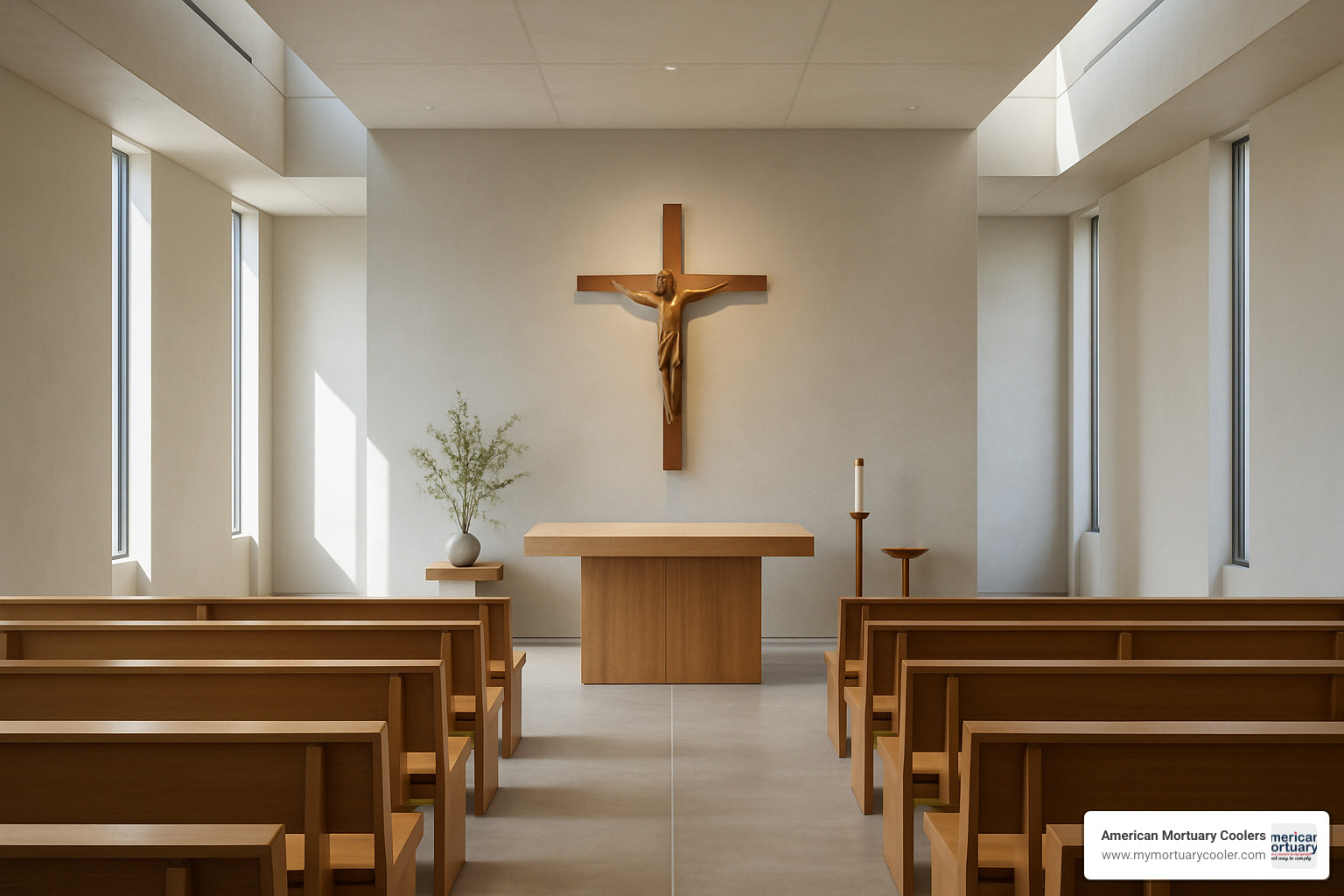
From Ivan Meštrović's soulful expressionist pieces to the neat refinement of Swiss mid-century designs, these crucifixes show us how religious art can evolve while keeping its spiritual heart intact. I've seen how these pieces continue to resonate in today's worship spaces, homes, and memorial settings – bridging traditional meaning with modern aesthetics in a way that feels both timeless and fresh.
For funeral directors and memorial space designers, the modernist crucifix offers something truly special – a deeply Christian symbol that harmonizes beautifully with contemporary architectural settings. This balance helps create environments that comfort diverse families with varying tastes and preferences during difficult times.
Here at American Mortuary Coolers, we understand that creating meaningful memorial experiences involves every element in the space. While our specialty is providing quality mortuary cooling systems, we recognize how thoughtful design choices like a well-placed modernist crucifix can transform an ordinary room into a dignified, comforting sanctuary.
Our team – from our headquarters in Johnson City, Tennessee to our representatives in Los Angeles – is always available to help you think through how these meaningful symbols can work alongside practical equipment needs. With our direct delivery service across the contiguous 48 states, funeral homes nationwide can access both essential equipment and design guidance to better serve their communities.
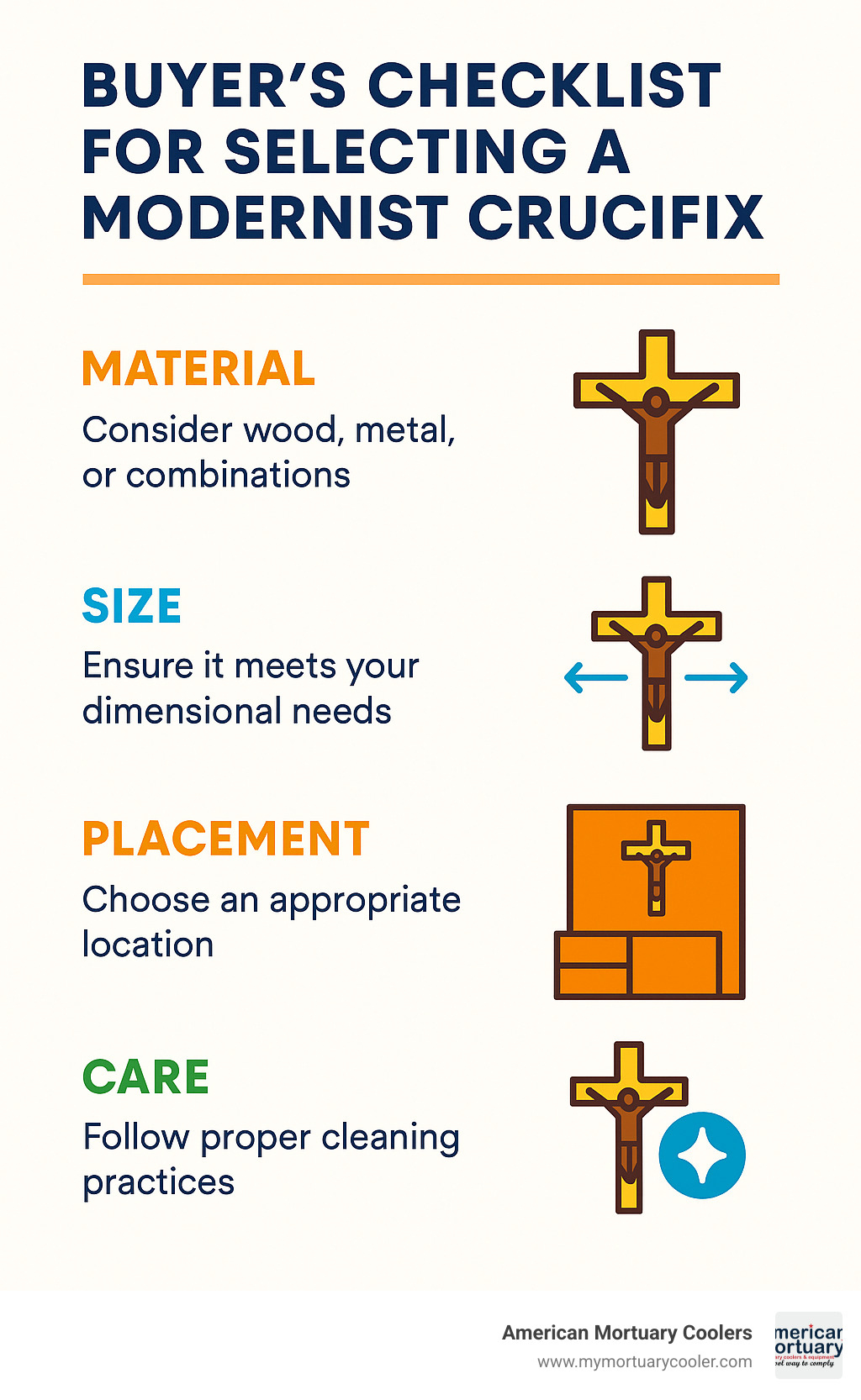
Whether you're considering a modernist crucifix for a newly designed chapel or looking to refresh an existing space, I hope this guide has given you valuable insights into these distinctive religious artifacts. Their clean simplicity, rich materials, and spiritual depth make them worth considering for any contemporary memorial setting that honors tradition while embracing modern design.
Need more guidance on creating cohesive, meaningful funeral spaces for today's diverse families? Reach out to our team at American Mortuary Coolers. We're here to support funeral professionals with both practical solutions and thoughtful guidance on creating environments that truly comfort, dignify, and honor.